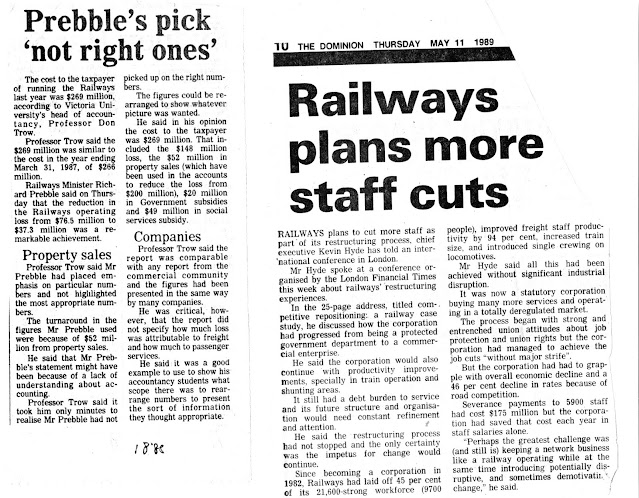This post has a fairly random selection of posts from the 1980s reflecting the period of restructuring...
 |
| Dominion 26 June 1986 |
In 1986 it was clear that Cabinet was about to approve the Railways Corporation closing the East Town Railway Workshops in Wanganui, but this put it at odds with one Cabinet Minister, the then MP for Wanganui, Russell Marshall. Both Marshall and Railways Minister Richard Prebble had promised before the 1984 election that the workshops would be saved. However, Prebble also indicated several times after the election that all the workshops could be saved by "rationalising" all the work. This proved not to be the case, and it was clear by 1986 that five railway workshops could not be retained. After East Town was closed, Addington would be closed in 1990, and Otahuhu in 1992. East Town was closed in 1986, but Russell Marshall narrowly retained his electorate in the 1987 election (although he lost over 10% of the vote share). Marshall retired in 1990.
 |
| 1 August 1988, 11 May 1989 |
The 1988 article quoting Victoria University accountancy professor Don Trow questioning Railways Minister Richard Prebble's claim that the reduction in the Railways Corporation's operating loss in 1987 compared to 1986 was "remarkable". Trow noting that the loss reduction was primarily due to a sale in surplus property. Trow said the Railways Corporation cost taxpayers $269m in that year, consisting of its operating loss, the sale of property and subsidies it received of $69m.
The 1989 reports on then Chief Executive Kevin Hyde presenting at a conference in London about the successes so far of restructuring the Railways Corporation. The presentation noted:
- Since 1982, 45% of Railways staff had been laid off (from 21,600 to 11,900).
- Freight staff productivity increased by 94%
- Increased train size and moved to single-crewed locomotives
- Staff reductions had been achieved with little industrial strife
- Freight rates reduced by 46% due to competition
- Severance payments to 5,900 staff had cost $175m, but it saved the Corporation the same each year.
The report noted that there would be further staff cuts.
In 1987, the Railways Corporation had three staff on most freight trains, with two in the locomotive cab and one in a guard's van. The article to the left noted that the Railways Corporation had achieved agreement with the relevant union to reduce the locomotive crew from two to one, starting with the electrified North Island Main Trunk, following with all other freight train services. The main measures needed to support it included some cab modifications and improved radio communications on lines.
In 1986 the Railways Corporation was proposing a significant cut in the Way and Works staffing by around a third.



No comments:
Post a Comment
Comments are gratefully received, but comments containing abuse or spam will be deleted